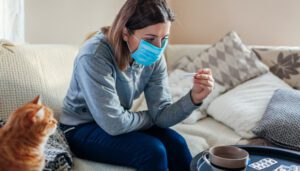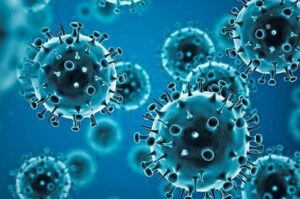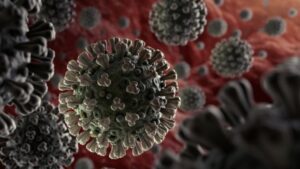
The period of self-isolation of persons who had contact with a patient with Covid-19 will now be determined by the attending physician in accordance with industry standards in the field of healthcare.
The corresponding norm was approved by the Cabinet of Ministers by Resolution No. 928 of August 19, which is published on its website.
Currently, this period should be 14 days, with a number of exceptions, including those who have completed a full vaccination course or have been ill in the last 180 days.
The new norm corresponds to the norm on the period of self-isolation of patients with Covid-19 and those who are suspected of being infected with Covid-19 – it is also determined by the attending physician.
In addition, as reported, the adopted resolution extended the quarantine from the end of August to the end of December this year.

The incidence of coronavirus in the world over the past week continued to decline, while mortality increased by 4%, follows from the weekly epidemiological bulletin of the World Health Organization (WHO).
Between June 6 and 12, the incidence of coronavirus decreased in all regions except the Eastern Mediterranean region, where the incidence increased by 58%, America (by 13%) and Southeast Asia (by 33%). The largest decline in cases was seen in the Western Pacific and Europe, at 8%.
In just a week, more than 3.2 million cases of COVID-19 were detected worldwide. Coronavirus deaths have decreased or remained unchanged in all regions except the Western Pacific, where deaths rose by 17%, and the Americas (21%). Mortality fell the most in the Eastern Mediterranean (by 35%). In general, more than 8.7 thousand deaths caused by COVID-19 were recorded worldwide during the week.
Over the entire period of the pandemic, about 535 million cases of coronavirus infection and more than 6.3 million deaths from the consequences of the disease have been detected in the world.

An expert group prepared by WHO intends to conduct a thorough analysis of the origin of the coronavirus, the Associated Press (AP) reported on Thursday.
“Further research is needed to determine how COVID-19 spread from the very beginning, including a more detailed analysis of the possibility of an abnormal situation in the laboratory,” the AP quotes excerpts from the report of the expert group.
The agency recalls that last year the US Department of Health announced that there was an extremely small possibility of the spread of COVID-19 among people due to a leak from the laboratory.
“Basic data to explain the emergence of the pandemic is still missing. Scientists said the group is open to any scientific evidence available to comprehensively explore all reasonable hypotheses,” the report says.
Infection with the coronavirus COVID-19 was first detected in the Chinese city of Wuhan in Hubei province at the end of 2019, then it began to spread around the world. On March 11, 2020, the WHO declared the coronavirus a pandemic.
By early April 2020, WHO reported that the number of cases of COVID-19 infection worldwide exceeded 1 million. By mid-October 2021, almost 240 million cases of infection had been registered worldwide.
Most scientists initially believed that COVID-19 was a virus of zoonotic origin. It is assumed that it could be transmitted to humans from bats. To determine the source of origin of the coronavirus, WHO initiated a special investigation. To this end, in early February 2021, a team of WHO experts visited the Wuhan Institute of Virology and, following the visit, concluded that a leak of viruses from the laboratory of the institute was “highly unlikely”. Many Western countries did not agree with the results of this investigation.
China has repeatedly opposed calls by WHO to conduct additional investigations in the country to determine the source of the origin of COVID-19.

The number of registered cases of coronavirus infection in the world as of Tuesday morning reached 532 million 350 thousand 904, according to data from the American Johns Hopkins University.
Since the beginning of the spread of the virus in the world, 6 million 300 thousand 53 people have died from the consequences of infection with COVID-19.
Countries with more than 20 million infections continue to include the United States, India, Brazil, France, Germany and the United Kingdom.
The number of infected and those who died from the consequences of infection, respectively, amounted to:
USA – 84 million 882 thousand 287 and 1 million 8 thousand 857.
India – 43 million 185 thousand 49 and 524 thousand 708.
Brazil – 31 million 195 thousand 118 and 667 thousand 41.
France – 29 million 834 thousand 390 and 149 thousand 509.
Germany – 26 million 498 thousand 361 and 139 thousand 388.
Great Britain – 22 million 526 thousand 949 and 179 thousand 532.
According to the portal Worldometers, which specializes in statistics on major world events, the death rate per 1 million people on the planet reached 811.0 on Tuesday morning. In the USA, 3 thousand 88 people died per 1 million inhabitants, India – 373, Brazil – 3 thousand 96, France – 2 thousand 265, Germany – 1 thousand 658, Great Britain – 2 thousand 608.

The World Health Organization (WHO) has reduced the number of coronavirus variants of concern to two. These currently include the Delta and Omicron strains of COVID-19.
“WHO has removed three strains from the list of coronavirus variants of concern – alpha, beta and gamma. Thus, two variants of COVID-19 remain on this list – delta and omicron,” the report says. posted Thursday on the organization’s website.
Also, WHO has excluded all variants of coronavirus from the list of strains of interest. Previously, this list included such strains of coronavirus as “epsilon”, “zeta”, “eta”, “theta”, “iota”, “kappa”, “lambda” and “mu”.

The COVID-19 pandemic has not ended, the Ministry of Health of Ukraine continues to provide oxygen supplies to COVID clinics, Minister of Health Viktor Liashko has said. “The coronavirus has not disappeared. There is only one pandemic in the world, nothing has disappeared, despite the fact that this topic is not on the front pages,” he said on the air of the 1+1 TV channel on Wednesday.
Liashko noted that the Ministry of Health continues to provide COVID hospitals with oxygen in the required volume.
He also said that there is enough COVID-19 vaccine in Ukraine, but the vaccine campaign is hampered by logistical problems.